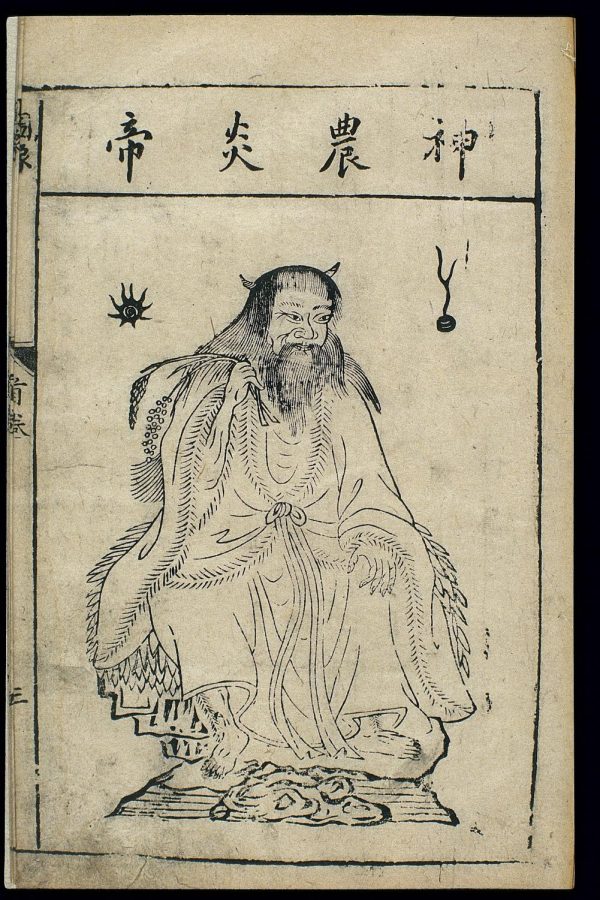The First Taste of Tea
December 21, 2022
Like every great discovery
It happened accidentally
When Camellia leaves fell in a bowl
Of boiling water, and, behold!
Infused it into tea!
If you are a tea drinker, you may have wondered where your tea comes from and who discovered this beverage.
Legend has it that tea as a beverage was discovered by the divine emperor Shennong, or Shen Nung, in China in 2732 BCE- almost 5,000 years ago!
According to Chinese mythology, Shennong was one of the Three Sovereigns or Three Emperors, a trio of mythological rulers and deities from ancient China between 2852 and 2070 BCE who established the Chinese life arts. The other two deities were called Fuxi and Hungdi. Shennong, the second of the three, is associated with fire and known as Yan Di (Emperor of Fire) and the God of the Burning Wind.
Believed to have been born the son of a princess and a heavenly dragon, his place of birth is variously given as somewhere along the Jiang River in the eastern border of what is today known as Shaanxi Province, slightly northeast of the ancient Chinese capital Xian in the Hua Shan mountains, in what is now Fufeng county or on Lishan, a mountain in Hubei Province. Shennong is believed to be the ancestor of both the Chinese and the Vietnamese people.
Fables say that due to his divine lineage, he was a child prodigy who started speaking when he was three days old, walked within a week and could plough a field at the age of three!
Shennong is reputed to have established the agricultural society in China. In addition to teaching his people to clear their fields by burning them, Shennong is said to have taught them how to farm, dig wells and irrigate their farms, preserve and store seeds, hold a weekly farmers market and celebrate the harvest with a Thanksgiving ceremony.
He also invented farming implements like the plough, hoe and axe, and tamed and yoked the ox and the horse. He taught his people to replace clams, meat and wild fruit in their diet with cultivated vegetables and grains like wheat, rice, millet, bean and sorghum, which he had discovered. As these crops are popularly known as the ‘five grains’, he is also called ‘Wugushen’ (Five Grains) or ‘Wuguxiandi’ (First Deity of the Five Grains). His name, Shennong, can be translated as Divine Husbandman or Divine Farmer.
Shennong is sometimes depicted draped in leaves, perhaps because, apart from his agricultural innovations, Shennong is believed to have tasted hundreds of plants to ascertain which were poisonous, which were edible and which had medicinal value. Known as the God of Medicine, his skill with herbal pharmacology is believed to have been divinely inspired. He categorized plants systematically, and his catalogue of 365 species of medicinal plants became the basis of traditional Chinese herbological studies recorded in books such as The Divine Farmer’s Herb-Root Classic which have been passed down for centuries.
He is reputed to have encountered seventy-two poisonous plants daily and, once he had discovered tea, used it as an antidote for at least seventy of them.
So, how did he discover tea?
Emperor Shennong was using twigs from a wild Camellia tree to boil water in a cauldron. Some scalded leaves from the burning twigs were carried upwards by a gust of wind and fell into his cauldron of boiling water. This was the first ever infusion of the tea leaf! As a pleasant fragrance wafted off the accidental brew, Shennong took a sip to taste it. Finding it refreshing, he drank some more. Thus, tea as a beverage was born and along with it, the very first tea drinker.
Being so knowledgeable and ahead of his times, he may have been boiling water to make it safe to drink. Whatever the reason, he was boiling water, the charred tea leaves fell into it and ‘tea’ was born!
Shennong named the brew ‘ch’a’, the Chinese character meaning ‘to check or investigate’. In 200 BCE, an emperor of the Han Dynasty ruled that a special written symbol illustrating a man between wooden branches and grass must be used when referring to tea. This written symbol, 荼, also pronounced ‘ch’a’, represented the way in which tea brought a balance between humankind and nature.
Shennong is said to have died in Cha Lin (Tea Hill) county of Hunan province while he was experimenting with the poisonous yellow flower of a weed. Unfortunately, the toxic overdose ruptured his innards before he could drink its antidote – tea! A cavern named Shennong Cave is widely believed to be his burial place.
“I normally partake of nothing more than medicinal wines, but I feel that this wine might be better for me than anything else.” I like to think that this quote attributed to Shennong refers to tea!



C. Hull • Dec 21, 2022 at 9:19 pm
Thank you for sharing this fascinating history of tea. Very insightful and well-written!